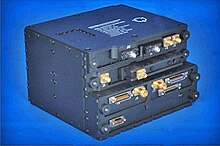


The Small Deep Space Transponder is a transponder designed by JPL specifically for deep space probes.[1] It unifies a number of communication functions - receiver, command detector, telemetry modulator, exciters, beacon tone generator, and control functions - into one 3-kg package. The SDST is designed to handle X band uplink and both X band and Ka band downlink. JPL estimates that performing the same functions with separate units (as was done previously) requires over twice the mass and 4 or 5 individual subassemblies.[2]
The capabilities of the SDST include:[3]
SDST has been used in the following missions:[4]
As many tightly constrained, high-performance systems, the SDST has a number of idiosyncrasies in operation.[5] However, as the Dawn telecom 'lessons learned' section points out, the use of common hardware such as the SDST allows knowledge of these characteristics from previous projects.[5]
For cubesat missions, the SDST is too big, heavy, and power-hungry. For these missions, the Iris transponder could be considered instead.